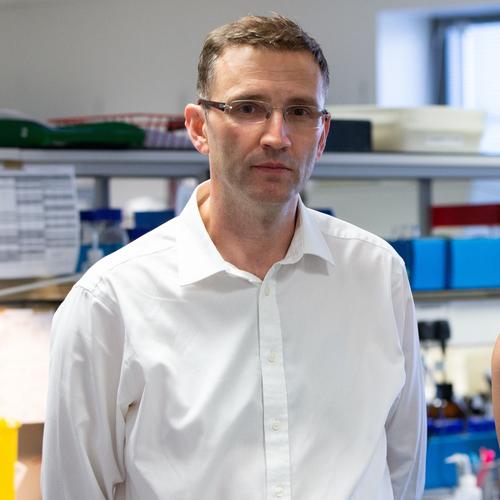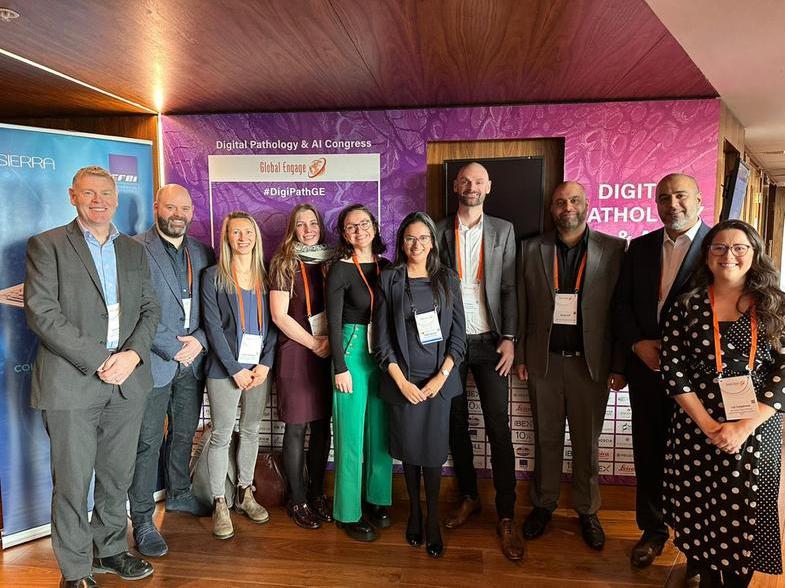Alongside his consultant role at Leeds Teaching Hospital and volunteer role at the College, Darren is also the Director of the National Pathology Imaging Co-operative (NPIC). NPIC are a national digital pathology platform for NHS. They are currently running a free webinar series discussing the fundamentals and potential of digital pathology, and how it can be implemented by NHS trusts.
The second webinar in this series, which will held at 3pm on Tuesday 7 May, is ‘Innovation into Practice – AI and its Ethical Challenges in Digital Pathology’. It provides an opportunity to learn more about the relationship between AI and pathology, and to pose your questions to the experts. You can register here.
Can you tell us about your background, and what drew you to pathology as a profession?
I studied at Trinity College Dublin, and during my degree we had a lot of exposure to laboratory science. We were taught pathology and microbiology by a very engaged pathology department at St James Hospital.
In our 3rd year we had hands-on tutorials from some very senior looking doctors (I later realised they were registrars in their late 20s!). They made me realise that there was a really interesting role in medicine that combined scientific knowledge with medical skills.
Also, I was the only person in my class who enjoyed histology and microbiology practicals!
How did you get interested in digital pathology?
Since childhood I’ve been interested in technology and computers, and I was lucky enough to go to a forward-thinking community school that was one of the first to have computers (BBC Micros, then Amstrad PCs, for those who care about those things). I really enjoyed learning how to make those machines do things; it felt like magic and still does.
My time as a pathology trainee at St Vincent’s Hospital Dublin in 1998 coincided with the arrival of a new digital imaging system. This had a fancy digital camera, a completely new device to me, and a computer with an unthinkably large 512 Megabytes of memory. Dr Tom Crotty was the driver behind this and he got me interested in the possibilities of digital imaging in pathology.
As I was drawing to the end of my time in Dublin, Tom mentioned that there were some devices in the USA capable of digitising the whole slide, which I immediately dismissed as an impossibly crazy idea. Little did I know what would come next.
My pathology training continued in Leeds in 2001, where I enrolled in a part-time evening degree in computing. I had another bit of luck and good timing when Professor Phil Quirke acquired funding for some Aperio scanners a few years later. I got involved in using them to support research and – crucially – was able to use my IT skills to develop the infrastructure to support the scanners. This led to the Leeds Virtual Pathology website, and my entire career in pathology has been dominated by this amazing technology of whole slide imaging.

You're currently Digital Pathology Lead at RCPath. Can you tell us more about your volunteer activities with the College? How long have you been involved and what does your current role entail?
I was inspired to get involved at the College by Dr Lance Sandle, who encouraged me to join the College Informatics Committee. Here, I learned a lot about how, as a profession, we can engage with and improve practice using informatics and computing.
The College – ahead of its time – saw the need for leadership in digital pathology, and I was appointed to the role of Digital Pathology Lead. At that time only a small number of labs globally were using digital pathology for clinical diagnosis, but there was growing interest.
The first job was to make guidelines for digital pathology for our members, so that they could safely adopt whole slide imaging in their labs while maintaining the same high standards of clinical practice. This led to the formation of our Digital Pathology Committee – a unique group of people with experience in digital pathology development and deployment, who now underpin all the work we do in digital.
What work has the College been doing around digital pathology, and how does this benefit members?
After writing the guidelines, the next job was to produce a digital pathology strategy for the following 5 years, aligned to the College’s 3-year strategy.
This led to the next few years of work, including activity across a range of areas:
-
advocating for investment for digital pathology and pathology labs at central NHS and government level
-
coordinating with Public Health England on the use of digital pathology in screening (which was approved last year)
-
helping standards development with NHS Digital in selected areas (cytology, molecular)
-
running annual training events
-
advising other College committees and functions, including advice on training and digital exams.
We also give personalised advice to individual Fellows. In the last few years, we’ve advised on remote working, validation guidelines, the role of digital pathology in supporting continued work during chronic illness, and tips and tricks for procurement.
However, the most impactful and important things we’ve produced are the digital pathology guidelines, and our position statement on the use of artificial intelligence in pathology. This was all ably supported by College staff, including Shane Johns at first and now Louise Mair.
You're the director of the National Pathology Imaging Co-Operative (NPIC), who have just launched a new webinar series on digital pathology. Can you tell us more about the NPIC and the webinar series?
Yes! NPIC is a national digital pathology platform for the whole of the NHS. It enables the clinical use of digital pathology and the creation of a unique innovation platform for AI and pathology research. We started in 2018 and the program will have 30–40 labs on board by 2025. We welcome others joining, so please get in touch if you’re interested.
Alongside our digital pathology deployment, NPIC has a training and knowledge theme led by my longstanding colleague Dr Bethany Williams. She has designed a comprehensive program covering everything in digital pathology from deployment through to AI development and evaluation, while also covering important topics such as ethics, public and patient involvement and quality assurance.

How do you hope the webinar series will benefit College members?
It offers an easily digestible end-to-end set of training in digital pathology and AI, designed to cover material for complete beginners and more advanced users. I hope they will find it helpful as part of their learning in digital and AI.
AI has been a hot topic recently. How has this been showing up within digital pathology, and how do you expect this to evolve in the future?
We’ve been using image analysis in histopathology for decades, but the latest AI is getting impressive results in analysing images – from the detection and grading of cancer through to predicting patient outcomes.
Because our images are relatively analysable (at least compared with other biomedical data), it's possible that digital pathology is one of the first areas in which we see benefits from using AI.
As a College, we welcome the possibilities offered by AI in medicine, and our position statement on AI outlines this. We need to ensure that pathologists are involved not just in using AI, but in developing it and making sure it works.
What have been the positives of volunteering with the College, and what advice would you give to other members interested in getting involved?
I think many people think of the College as some distant body that does things to pathologists. In fact, the College is the members, and it’s only if we members engage that we can achieve things.
I had little to do with the College in my early career apart from doing the exams! But now in my work at the College I’ve seen the huge amount of usually thankless work put in by the elected members, and the dedication of College staff to support us as a profession. The more of us that get involved, the stronger we will be. I’d encourage every member who has a view on how we should work or what the future of pathology should be to get involved.
How can members get involved in the College's work in digital pathology?
There’s an explosion of interest and use of digital pathology and AI in laboratories. We encourage members to embrace the technology and ensure they are at the forefront of this revolution.
Personally, I’d encourage members to ensure they capture as much data in as systematic a way as possible about their experience of digital pathology and AI – impact on workload/workflow, experiences in the real world of their use, and real world accuracy.
We’ll continue our educational offer to members, so we increase the general levels of understanding of the technology and equip us for a digital and AI future.
Also, members can email us with questions, suggestions or requests.
If you’re interested in learning more about digital pathology and its potential to advance the profession, remember to register for the NPIC webinar series. These sessions will be occurring monthly, providing first-hand expertise on how to better implement digital pathology into your practice.

